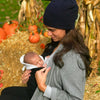Snooze Series: How Babywearing Can Keep You and Your Baby Happy
by Bryant Figueroa on Apr 11, 2017
By Elizabeth Pantley, author of The No-Cry Sleep Solution for Newborns
Babywearing – carrying your baby in a soft baby carrier or sling – is a great way to provide your baby with the important and soothing experience of being held, while you get freedom to have two arms free and move about the house or run errands while you are recreating a wonderful womb-like experience for your little one.
Walking with your baby in a carrier is a great way to soothe him at the end of a long day, especially if your baby is colicky, or if you are feeling worn down or tense. Babies can sense that tension in your arms, plus your arms, shoulders and back can only last so long – babywearing helps provide a more relaxed method of carrying your baby for any length of time.
Newborn naps in the carrier
Your baby’s carrier may quickly become the ideal happy-napping place when your baby is feeling fussy or resisting sleep. It’s the most effective place for your baby to find that swaying, rocking, womb-like feeling that soothes your baby and brings easy sleep. As long as you are comfortable and willing, a soft-carrier nap is pure joy to your baby, and a real endorphin boost for you, too.

Keeping Baby safe and comfortable
It’s important to be certain that you are using your carrier correctly and that your baby is positioned properly within the carrier or sling to be perfectly safe. Here are a few of the most important safety rules for babywearing:
- Choose a carrier or sling that is intended for your baby’s size and age, plus your height and weight. Read and follow the product instructions for use.
- Newborns should be carried upright (vertical) except when actively breastfeeding.
- Carrier should be snug enough to support your baby’s back and keep your baby in place while allowing ample room for breathing.
- Your baby should belly-up to your body, with his knees higher than his bottom in an “M” shaped frog position. (Watch for carriers labeled as a “hip-healthy product” by the International Hip Dysplasia Institute.) Babies should only be placed in an outward-facing position when they are much older and have more balance and full control of their head and neck.
- You should be able to see your baby’s face when you look down. It should not be burrowed into your body or covered by fabric.
- Your baby’s chin should not be curled down into his chest, as this position could impede breathing.
- Baby should be held high enough for you to be able to kiss his head. Always: Close enough to kiss!
- Double check all aspects of the carrier at each use to make sure that everything is secure and arranged properly.
- Be careful when babywearing and trying to do other activities, such as cooking or doing yardwork. You don’t want to accidentally fall, bump your baby, cause a burn or otherwise accidentally harm your little one.
- As your baby grows make sure your carrier is still suitable for her size and age.
|
Read More in our Sleep Series: 4 Easy Ways to Help Your Newborn Sleep Better The Benefits of Swaddling Your Newborn |
About The Author:
|




